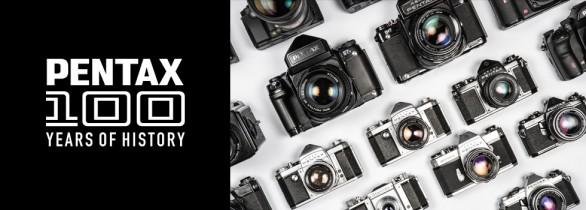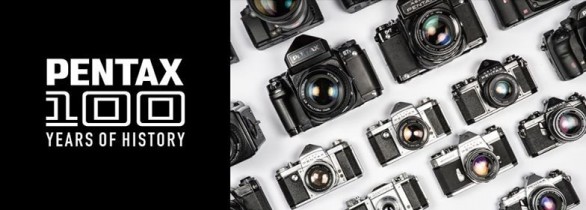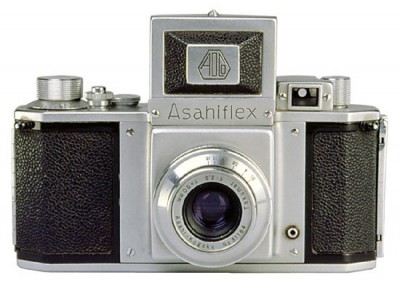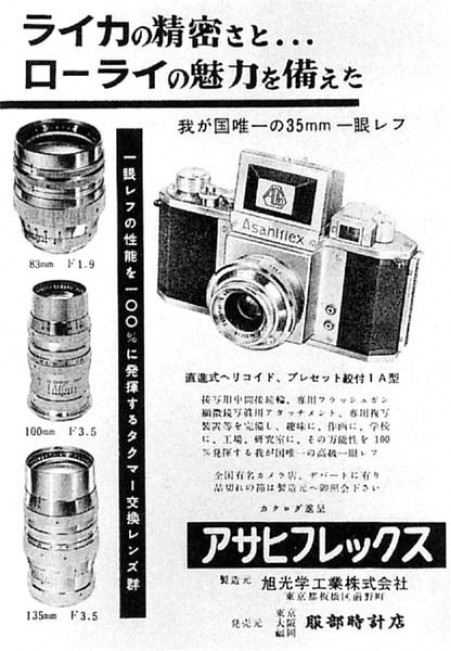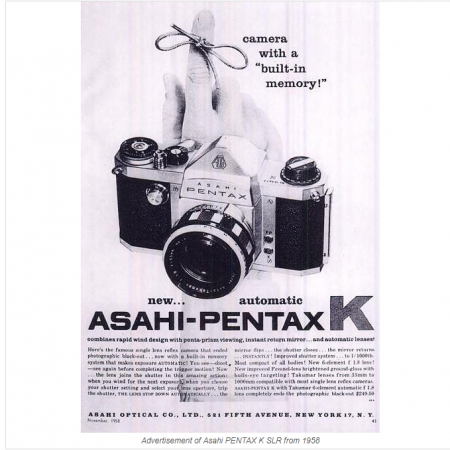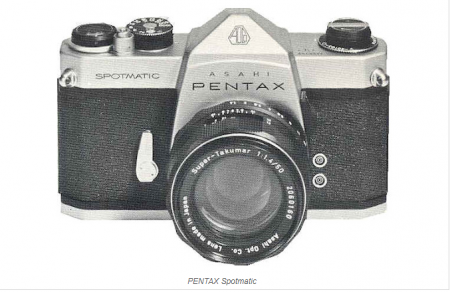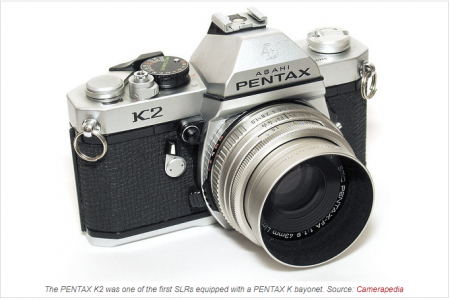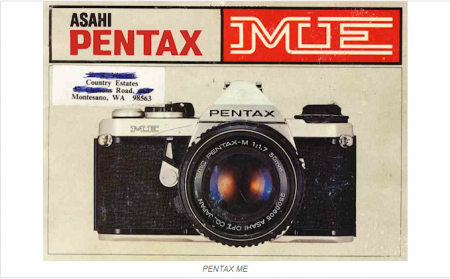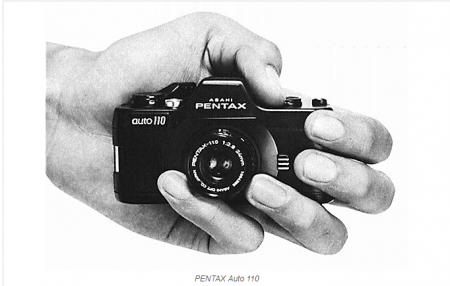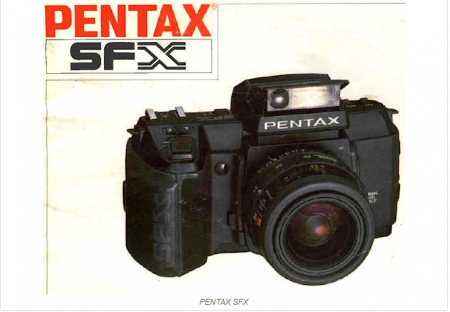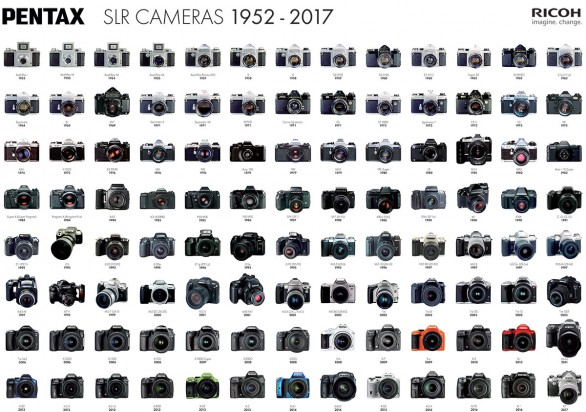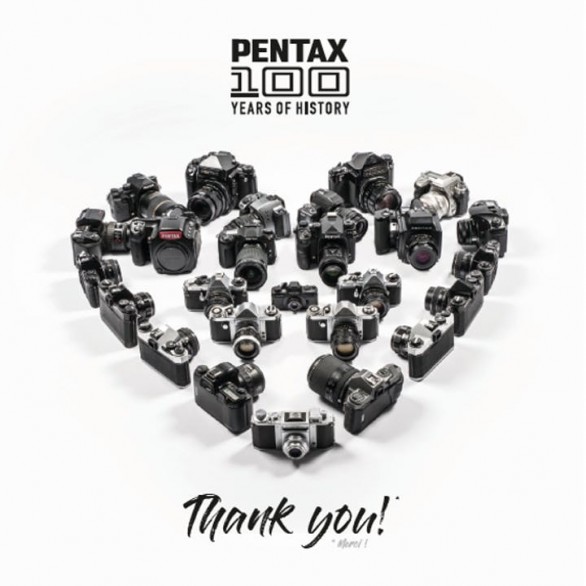Pentax 100 år - 27.nov. 2019
The trade name PENTAX was created over half a century ago, but to find its roots, we have to go back to November 1919, when a Kumao Kajiwara in Tokyo Toshima founded a company called Asahi Kogaku Goshi Kaisha (Asahi Optical Joint Stock Co.).
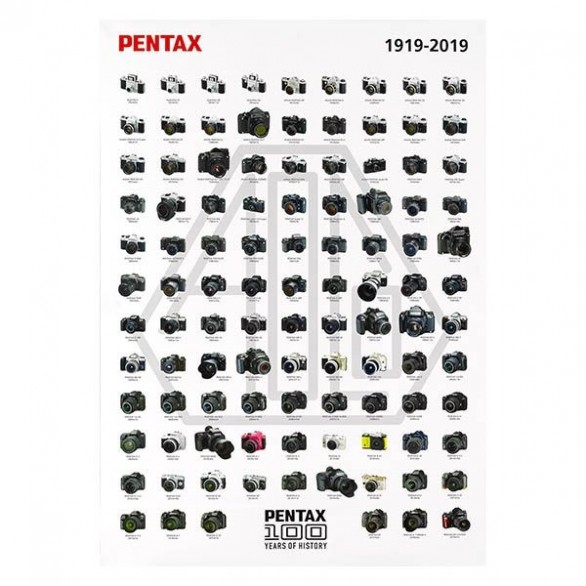
Asahi means the rising sun, which in a certain way obliged the company to dynamic development. No wonder that from the very beginning of its existence, thanks to the use of modern glass polishing techniques, the company became known as a producer of high quality lenses used in spectacles, telescopes and other civil and military optical instruments. In 1923, the production of the first lenses for film projectors began, which allowed the company to develop over the next few years and work on extending the offer with new products.
Thanks to this, in 1929, lenses for photographic cameras were designed.
The result of this work was the Corona Anastigmat 105 mm f / 4.5 triplet introduced in 1931, which was mounted on the 6.5 × 9 cm Happy Hand Camera, produced by the Molta Camera Company, the then Minolta. In the following years Asahi's offer also included Actiplan Anastigma 105 mm f / 4.5 for Minolta and Auto Minolta rangefinders and Corona Anastigmat 75 mm f / 4.5 for Semi Minolta cameras for film 120. Cooperation with Minolta lasted until the beginning of World War II. During these years, among others, 4-element Tessar type lenses called Promat Anastigmat and 75 mm and 105 mm focal lengths, which had a f / 3.5 light intensity and were mounted in Auto Semi Minolta and Auto Press Minolta cameras.
In the years 1932-1933, Asahi cooperated with another large producer of cameras - Konishi, which is the progenitor of all Konik's well-known company. Also in this case, the cooperation consisted of providing photographic lenses. They were initially assembled in the Pearlette 127 series, and in the later period the Opel Anastigmat 105 mm f / 4.5 triplet produced by Asahi replaced the German Tinar Anastigmat 105 mm f / 6.3 lens used in the Konishi Idea Showa 8 and Konishi Pearl Showa 8 6.5 × format 9 cm
This translated into further development of the company, which in 1934 built a new factory outside Tokyo. After the death of Mr. Kumao Kajiwara, her long time employee, Mr. Saburo Matsumoto, managed the company. He saw huge potential in the photo market and therefore he intended to focus on developing this business profile. Unfortunately, in 1937, Asahi, like most Japanese producers, went under the supervision of the military government and was forced to produce optical instruments for the army – that stopped their plans of photography. Matsumoto quickly found a way out of this situation and in 1938 he bought a small factory in Tokyo, which he named Asahi Optical Co. Ltd. and moved to it the production of photographic lenses. Unfortunately, this procedure did not help much, because in a short time the new plant was also forced to manufacture for the needs of the army.
The period of the Second World War was not conducive to the development of the consumer photography market, however, thanks to the production of Asahi photo equipment, it could still be in the photo business and develop its production technologies.
After the war, the company fell into debt. As a result, Matsumoto was forced to sell the surviving equipment of the company. The company managed to resume operations in the summer of 1946, when they received first orders from the US Army for the supply of binocular lenses. Soon after, contracts were also signed with local companies and the production of lenses started in Asahi at full steam.

However, Matsumoto dreamed for the company to be a full-fledged manufacture of consumer products and not only a supplier of parts and. This plan was achieved in the spring of 1948, when the new name of Asahi Kogaku Kogo Kabushi Kaisha (Asahi Optical Co. Ltd) introduced a telescope for observing the solar eclipse, which in May of the same year was visible in northern Japan. Although the telescope tube was made of cardboard, it contained high-quality lenses that made it very popular. However, the real hit of the market was the miniature 6 × 15 Jupiter binoculars presented in the same year. Asahi developed on its lenses the anti-reflection coatings in cooperation with the University of Nagoya, which guaranteed excellent optical properties and placed Jupiter in the forefront of binoculars of that class at that time.
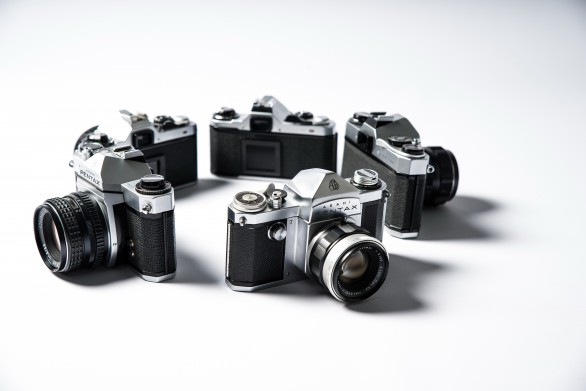
At the turn of the 1940s and 1950s, the company also restarted cooperate with camera manufacturers, and as a result, thousands of lenses were produced per month, installed in Chiyoda Kogaku Seiko KK (Minolta), Konishiroku Shashin Kogyo KK (Konica ) and Sanwa Shokai Co., Ltd.
Despite business increase, Mr. Matsumoto still dreamed of creating a camera under his own brand. However, he did not want to follow the path set by competing companies from Japan, who often copied Rolleiflex dual-lens reflex cameras and Leica rangefinders and wanted to offer their own innovative product. Therefore, he focused his efforts on developing a 35mm single-lens reflex camera, because he believed that this is the type of camera the future of photography. Work on the Asahi reflex camera began in 1949, but despite time and efforts, there were no expecting result. Mr. Matsumoto concluded that without a proper team of qualified engineers he would not be able to fulfil his dream. He therefore asked for help to Mr. Ryohei Suzuki, who from 1933 worked for another lens manufacturer cooperating with Konishiroku. Mr. Nobuyuki Yoshida, a colleague of Mr. Suzuki, who also worked for Konishiroku before, came to help as camera engineer. The engineers sat down to the drawing tables with the assumption that Yoshida would create a SLR camera body, and Suzuki would be dedicated to her lenses.
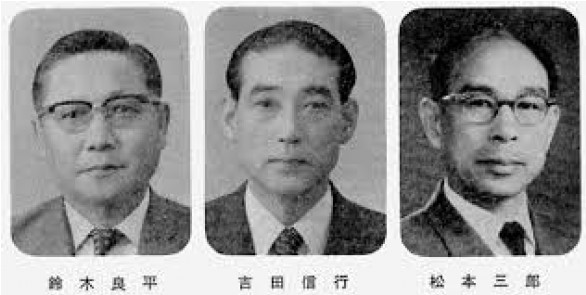 Asahi Optical project team: (from left) Ryohei Suzuki, Nobuyuki Yoshida, Saburo Matsumoto
Asahi Optical project team: (from left) Ryohei Suzuki, Nobuyuki Yoshida, Saburo Matsumoto
In 1951, Asahi could boast of the first prototype of its 35mm single-lens reflex camera, under the name Asahiflex.
The camera went into production in 1952 under the name Asahiflex I, the first Japanese single-lens reflex camera for 35 mm film. Although it was sold only in the Land of the Rising Sun, it stood out among other products of this type sold all over the world. It had a mirror mechanism associated with the shutter release - after removing the finger from the trigger the mirror returned to the rest position. It was just a substitute for a self-reversing mirror, but the solution was more innovative than it was used in most SLRs, in which the mirror was dropped only after the film was stretched. Unfortunately, it created problems at longer shutter speeds, where it was necessary to hold the trigger until it was closed so that the falling mirror did not obscure the photosensitive material. It is worth noting here that in a DSLR the image in the optical viewfinder is visible only when the mirror is lowered, which is why it is important to return it to the rest position as soon as possible. Otherwise the viewfinder is dark and we can not frame.
The reflex camera Asahiflex I was offered in the years 1952-53.
The camera offered quite non-standard shutter speeds: B, 1/20, 1/30, 1/40, 1/60, 1/100, 1/200, 1/500 sec and although it enjoyed quite a lot of popularity in Japan - sold in total about 7,500 copies of this model. In 1953, the production of the Asahiflex IA was started, which included an additional sync connector (X-sync) for the external flash. The shutter structure was also changed, thanks to which it was possible to set the times: B, 1/25, 1/50, 1/100, 1/200 and 1/500 s.
Advertising of the Asahiflex
Asahiflex IA sold 11,500 units, but the real hit was the Asahiflex IIB model presented in 1954. It was also sold in the USA and was equipped with a self-reversing mirror, which dropped as soon as the shutter was closed. The producer in commercials boasted that this is the first SLR camera with this type of solution. The self-reversing mirror was also used in a prototype Japanese Orchid medium-format reflex camera that never entered series production. So in the case of Asahiflex IIB we can only talk about the first mass-produced SLR offered on the world market, in which a self-reversing mirror was used. The camera has its successor, the Asahiflex IIA.
The development of Asahiflex SLRs went hand in hand with the development of 37 mm thread lines. In addition to the already mentioned Takumara 50 / 3.5, Asahi also offered models with 58, 83, 135 and 500 mm focal lengths. It is also worth devoting a few words just to explain the name Takumar. It comes from the name of the Japanese painter Takum Kajiwara, who was the uncle of Mr. Matsumoto.
Production of the first series of Asahiflex SLRs ended in 1957, when the manufacturer presented the world's first Japanese single-lens reflex camera equipped with a viewfinder using a pentagonal prism. It was called Asahi PENTAX - from the words PENTA prism (a pentagonal prism) and Asahifle X (the first Japanese SLR 35 mm). This sonorous combination of words gave rise to the legendary brand and the whole PENTAX series, which have been produced continuously for over 50 years.
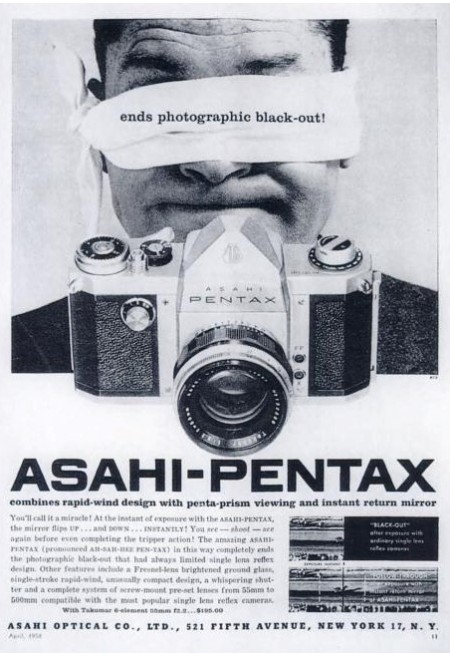
Advertisement of Asahi PENTAX SLR from 1958

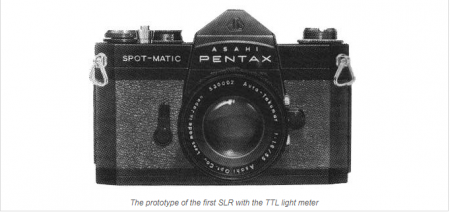
However, it took the producer 4 years to refine the light meter and only in 1964 the world's first DSLR camera with TTL light measurement - PENTAX Spotmatic - was launched.
The TTL light meter built into the body turned out to be what almost the entire world of photography was waiting for and as a result PENTAX Spotmatic became a huge market hit. Thanks to this, as early as 1966, Asahi Optical , is the first company in the world to reach a million SRLs sold.
Another million sold only in two years. Spomatic was still very popular - a total sales represent 3 million units. For several years, the manufacturer did not have to focus on developing further SLR models, but only needed to launch a new factory in Tochigi, which allowed providing the appropriate production capacity. It was not until 1968 that a new DSLR was presented. It was a PENTAX SL model, which was based on the PENTAX Spomatic body, but it was deprived of a light meter. A year later, the medium format PENTAX 6 × 7 camera was introduced to the market.
However, another breakthrough appeared in 1971 with the premiere of the PENTAX Spomatic II reflex camera. Although the body itself did not introduce too many changes in relation to the previous model, it was offered with completely new lenses, equipped with lenses with applied multilayer Super Multi Coated (SMC) antireflection layers. The coatings consisted of seven layers and no one had previously used this type of solution in lenses, so the producer could once again boast that he was the first to introduce a new technology for photography.
The year 1971 was also a breakthrough from the business point, because the company debuted on the Tokyo Stock Exchange, and the money raised from investors could be used to purchase the first foreign factories in Hong Kong and Taiwan.
In the next two years, Asahi Optical presented as many as seven new DSLRs, but after 1973 there was a 2-year break in the premieres of the cameras, because in 1974 the constructors took a rather bold decision and decided to change the lens mount. Thread 42 × 1 mm was already an outdated standard and PENTAX lagged behind other producers who offered bayonet mountings. Therefore, in 1975, the first SLRs fitted with a completely new bayonet, which was named PENTAX K, were released. Fortunately, the manufacturer did not forget about millions of lens holders with M42 thread and designed the new PENTAX K bayonet so that it also allows easy connection older lenses. PENTAX takes care of it to this day and thanks to this, even to the newest PENTAX digital SLR cameras currently available in stores, we can easily mount M42 lenses. All we need is a cheap adapter and we can enjoy even confirmation of the focus through the body and sharpening to the infinite.The first PENTAX K D-SLR cameras were the PENTAX K2, PENTAX KX, PENTAX KM and PENTAX K1000 models. They were based on the last bodies with the M42 thread, i.e. Spotmatic F and ESII.
In parallel with the series of "K" SLRs, the manufacturer developed the "M" series, which was launched in 1976 by PENTAX MX and ME. They were small and light SLR cameras to compete with the then-popular Olympus OM1. The Asahi company offered dedicated SMC PENTAX M lenses to the new products. Although they had a PENTAX K bayonet, their stylistics and sizes were adapted to the neat MX and ME bodies.
The "M" series was developed until 1980, and it was crowned with a professional reflex camera with a rather unusual PENTAX LX designation. It came from the Roman record number 60, which was to symbolize the 60th anniversary of Asahi. Such a jubilee obliges, so it should not come as a surprise that the manufacturer again showed considerable innovativeness and the PENTAX LX was the first modular SLR with seals protecting against moisture and dust.
LX modularity consisted in the possibility of replacing the entire sighting system with the mat and prisms. This gave more flexibility when photographing different scenes and themes. However, the mentioned seals against moisture and dust are today a characteristic feature of most SLRs with the PENTAX logo.
At the turn of the 70s and 80s of the last century, Asahi has made three entries in the history of photography. First, in 1979, she presented the first camera for film 110 with replaceable optics, i.e. the PENTAX Auto 110 model.
Then in 1980, the world saw the world's first SLR camera with the TTL AF system, the PENTAX ME-F model. It was based on the ME Super model, however, it was packed with electronics, which at that time was unreliable and as a result the camera was known as a quite an emergency product. As if that was not enough autofocus in the ME-F worked only with one lens SMC PENTAX AF ZOOM 35-70 mm f / 2.8, which for auto focus used a built-in motor powered by 4 AAA batteries and as a result, the lens weighed as much as 580 grams. All these inconveniences caused that although PENTAX ME-F was certainly an innovative and breakthrough product, the market did not accept it too enthusiastically. It is also worth mentioning that with the premiere of ME-F we witnessed the first evolution of the PENTAX K bayonet. The new version of the mount was marked with the PENTAX KF symbol and used 5 electronic contacts responsible for transmitting the information necessary for automatic focusing.
The third historic moment was the production of a total of 10 million DSLRs, which was achieved by the company in 1981.
The 1980s brought together more than a dozen models of SLRs, among which we can find a medium-format PENTAX 645 camera, as well as the PENTAX Super A presented in 1983, in which another version of the bayonet marked PENTAX KA was introduced. Along with the camera on the market there were also excellent PENTAX KA lenses, such as SMC Pentax-A * 85 mm f / 1.4 and SMC Pentax-A * 135 mm f / 1.8, which allowed the use of PASM programs.The PENTAX KA bayonet turned out to be very forward-looking because it is used today, despite the fact that in the last 30 years the amount of information exchanged between the lens and the body is much larger. As a result, as early as 1987, Asahi was able to present its first SLR camera with the PENTAX SFX symbol, which did not require additional power supply in the lens. It was hailed as the first SLR camera with a built-in flash and ended the era of manual SLRs with the PENTAX logo.





